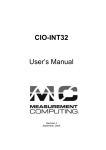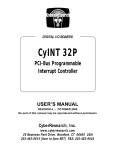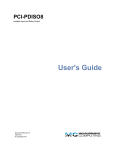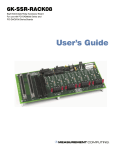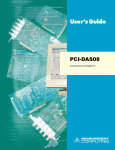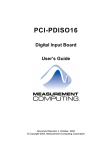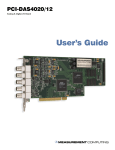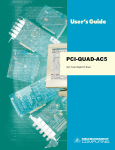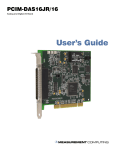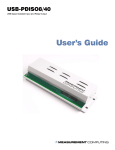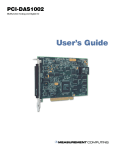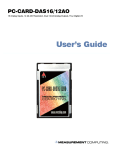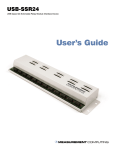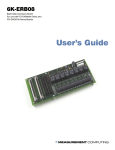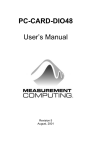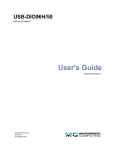Download PCI-INT32 User`s Guide - Coulbourn Instruments
Transcript
PCI-INT32 Interrupt/Counter Board User's Guide Document Revision 5, May, 2005 © Copyright 2005, Measurement Computing Corporation Your new Measurement Computing product comes with a fantastic extra — Management committed to your satisfaction! Refer to www.mccdaq.com/execteam.html for the names, titles, and contact information of each key executive at Measurement Computing. Thank you for choosing a Measurement Computing product—and congratulations! You own the finest, and you can now enjoy the protection of the most comprehensive warranties and unmatched phone tech support. It’s the embodiment of our two missions: To offer the highest-quality, computer-based data acquisition, control, and GPIB hardware and software available— at the best possible price. To offer our customers superior post-sale support—FREE. Whether providing unrivaled telephone technical and sales support on our latest product offerings, or continuing that same first-rate support on older products and operating systems, we’re committed to you! Lifetime warranty: Every hardware product manufactured by Measurement Computing Corporation is warranted against defects in materials or workmanship for the life of the product. Products found defective are repaired or replaced promptly. Lifetime Harsh Environment Warranty®: We will replace any product manufactured by Measurement Computing Corporation that is damaged (even due to misuse) for only 50% of the current list price. I/O boards face some tough operating conditionssome more severe than the boards are designed to withstand. When a board becomes damaged, just return the unit with an order for its replacement at only 50% of the current list price. We don’t need to profit from your misfortune. By the way, we honor this warranty for any manufacturer’s board that we have a replacement for. 30 Day Money Back Guarantee: You may return any Measurement Computing Corporation product within 30 days of purchase for a full refund of the price paid for the product being returned. If you are not satisfied, or chose the wrong product by mistake, you do not have to keep it. Please call for an RMA number first. No credits or returns accepted without a copy of the original invoice. Some software products are subject to a repackaging fee. These warranties are in lieu of all other warranties, expressed or implied, including any implied warranty of merchantability or fitness for a particular application. The remedies provided herein are the buyer’s sole and exclusive remedies. Neither Measurement Computing Corporation, nor its employees shall be liable for any direct or indirect, special, incidental or consequential damage arising from the use of its products, even if Measurement Computing Corporation has been notified in advance of the possibility of such damages. HM PCI-INT32.doc ii Trademark and Copyright Information Measurement Advantage brand, TracerDAQ, Universal Library, InstaCal, Harsh Environment Warranty, Measurement Computing Corporation, and the Measurement Computing logo are either trademarks or registered trademarks of Measurement Computing Corporation. SoftWIRE is a registered trademark of SoftWIRE Technology, Inc. Windows, Microsoft, and Visual Studio are either trademarks or registered trademarks of Microsoft Corporation LabVIEW is a trademark of National Instruments. All other trademarks are the property of their respective owners. Information furnished by Measurement Computing Corporation is believed to be accurate and reliable. However, no responsibility is assumed by Measurement Computing Corporation neither for its use; nor for any infringements of patents or other rights of third parties, which may result from its use. No license is granted by implication or otherwise under any patent or copyrights of Measurement Computing Corporation. All rights reserved. No part of this publication may be reproduced, stored in a retrieval system, or transmitted, in any form by any means, electronic, mechanical, by photocopying, recording, or otherwise without the prior written permission of Measurement Computing Corporation. Notice Measurement Computing Corporation does not authorize any Measurement Computing Corporation product for use in life support systems and/or devices without the written approval of the CEO of Measurement Computing Corporation. Life support devices/systems are devices or systems which, a) are intended for surgical implantation into the body, or b) support or sustain life and whose failure to perform can be reasonably expected to result in injury. Measurement Computing Corporation products are not designed with the components required, and are not subject to the testing required to ensure a level of reliability suitable for the treatment and diagnosis of people. iii Table of Contents About this User's Guide .......................................................................................................................v What you will learn from this user's guide .........................................................................................................v Conventions in this user's guide........................................................................................................................................ v Where to find more information ...................................................................................................................................... vi Chapter 1 Introducing the PCI-INT32 ................................................................................................................ 1-1 Software features ............................................................................................................................................ 1-1 Chapter 2 Installing the PCI-INT32 .................................................................................................................... 2-1 What comes with your PCI-INT32 shipment?................................................................................................ 2-1 Hardware ....................................................................................................................................................................... 2-1 Software......................................................................................................................................................................... 2-1 Documentation............................................................................................................................................................... 2-1 Optional components ..................................................................................................................................................... 2-2 Unpacking the board....................................................................................................................................... 2-2 Installing the software .................................................................................................................................... 2-3 Installing the hardware ................................................................................................................................... 2-3 Connecting the board for I/O operations ........................................................................................................ 2-3 Connectors, cables – main I/O connector....................................................................................................................... 2-3 Field wiring and signal termination accessories............................................................................................................. 2-4 Chapter 3 Programming and Developing Applications .................................................................................. 3-1 Programming languages ................................................................................................................................. 3-1 Packaged applications programs..................................................................................................................... 3-1 Register-level programming ........................................................................................................................... 3-1 Chapter 4 Functional Details ............................................................................................................................. 4-1 DIO signals..................................................................................................................................................... 4-1 Pull-up/down resistors ................................................................................................................................................... 4-1 Chapter 5 Specifications.................................................................................................................................... 5-1 Power consumption ........................................................................................................................................ 5-1 Counter/timer and parallel I/O........................................................................................................................ 5-1 Interrupts......................................................................................................................................................... 5-1 Environmental ................................................................................................................................................ 5-2 iv Preface About this User's Guide What you will learn from this user's guide This user's guide explains how to install, configure, and use the PCI-INT32 so that you get the most out of the board's interrupt and counter features. This user's guide also refers you to related documents available on our web site, and to technical support resources. Conventions in this user's guide For more information on … Text presented in a box signifies additional information and helpful hints related to the subject matter you are reading. Caution! Shaded caution statements present information to help you avoid injuring yourself and others, damaging your hardware, or losing your data. <#:#> Angle brackets that enclose numbers separated by a colon signify a range of numbers, such as those assigned to registers, bit settings, etc. bold text Bold text is used for the names of objects on the screen, such as buttons, text boxes, and check boxes. For example: 1. Insert the disk or CD and click the OK button. italic text Italic text is used for the names of manuals and help topic titles, and to emphasize a word or phrase. For example: The InstaCal® installation procedure is explained in the DAQ Software Quick Start. Never touch the exposed pins or circuit connections on the board. v PCI-INT32 User's Guide About this User's Guide Where to find more information The following electronic documents provide helpful information relevant to the operation of the PCIINT32. MCC's Specifications: PCI-INT32 (the PDF version of Chapter 5 in this guide) is available on our web site at www.mccdaq.com/pdfs/pci-int32.pdf. MCC's Register Map for the PCI-INT32 is available on our web site at www.mccdaq.com/registermaps/RegMapPCI-INT32.pdf. MCC's DAQ Software Quick Start is available on our web site at www.mccdaq.com/PDFmanuals/DAQ-Software-Quick-Start.pdf. MCC's Guide to Signal Connections is available on our web site at www.mccdaq.com/signals/signals.pdf. MCC's Universal Library User's Guide is available on our web site at www.mccdaq.com/PDFmanuals/sm-ul-user-guide.pdf. MCC's Universal Library Function Reference is available on our web site at www.mccdaq.com/PDFmanuals/sm-ul-functions.pdf. MCC's Universal Library for LabVIEW™ User’s Guide is available on our web site at www.mccdaq.com/PDFmanuals/SM-UL-LabVIEW.pdf. The ZILOG Z8036/Z8536 Product Specification is available on our web site at www.mccdaq.com/PDFmanuals/Z8536.pdf. This user's manual is also available on our web site at www.mccdaq.com/PDFmanuals/PCI-INT32.pdf. vi Chapter 1 Introducing the PCI-INT32 The PCI-INT32 is intended to be used in conjunction with the ZILOG Z8036/Z8536 Product Specification. This document is available on our web site at www.mccdaq.com/PDFmanuals/Z8536.pdf. The PCI-INT32 can accept up to 32 vector interrupts and output an interrupt to the PC. The board has a pair of Z8536 I/O chips interfaced to the PCI bus. Each Z8536 accepts up to 16 independent inputs that can be used to generate interrupts from bit patterns or individual bit states or transitions. The interrupt outputs from two X8536 chips can be ANDed using software. Many other functions can be performed by the PCI-INT32 including digital pattern recognition, counting with six 16-bit counters, and up to 40 bits of digital I/O. The 16-bit counters can be set up independently or chained together in groups of three. The I/O pins of the Z8536 are TTL levels. All I/O lines are accessible through a 50-pin header connector. Connections to the board typically use the C50FF-# cable and the CIO-MINI50 terminal board. Software features The following software ships with the PCI-INT32 free of charge. InstaCal installation, calibration, and test utility TracerDAQ™ suite of virtual instruments+ SoftWIRE® for Visual Studio® .NET graphical programming MCC DAQ Components for VS .NET (installed with SoftWIRE® for VS .NET) For information on the features of InstaCal, TracerDAQ, and SoftWIRE, refer to the DAQ Software Quick Start booklet that shipped with the PCI-INT32. 1-1 PCI-INT32 User's Guide Introducing the PCI-INT32 PCI-INT32 functions are illustrated in the block diagram shown here. Figure 1-1. PCI-INT32 functional block diagram 1-2 Chapter 2 Installing the PCI-INT32 What comes with your PCI-INT32 shipment? As you unpack your board, make sure that the following components are included. Hardware PCI-INT32 Software The Measurement Computing Data Acquisition Software CD contains the following software: InstaCal installation, calibration, and test utility TracerDAQ suite of virtual instruments SoftWIRE for VS .NET SoftWIRE MCC DAQ Components for .NET (installed with SoftWIRE for VS .NET) Documentation In addition to this hardware user's guide, you should also receive the DAQ Software Quick Start (available in PDF at www.mccdaq.com/PDFmanuals/DAQ-Software-Quick-Start.pdf). Please read this booklet completely before installing any software and hardware. 2-1 PCI-INT32 User's Guide Installing the PCI-INT32 Optional components If you ordered any of the following products with your board, they should be included with your shipment. Universal Library Universal Library™ Data Acquisition and Control Programming Tools (also includes the InstaCal installation package, the Universal Library User's Guide, and the Universal Library Function Reference) Cables C50FF-x Signal termination and conditioning accessories MCC provides signal termination and signal conditioning products for use with the PCI-INT32. Refer to the Field wiring, signal termination and conditioning section for a complete list of compatible accessory products. Unpacking the board The PCI-INT32 board is shipped in an antistatic container to prevent damage by an electrostatic discharge. To avoid such damage, perform the following procedure when unpacking and handling your board: 1. Before opening the antistatic container, ground yourself with a wrist-grounding strap or by holding onto a grounded object (such as the computer chassis). 2. Touch the antistatic container to the computer chassis before removing the board from the container. 3. Remove the board from the container. Never touch the exposed pins or circuit connections on the board. 2-2 PCI-INT32 User's Guide Installing the PCI-INT32 If your PCI-INT32 is damaged, notify Measurement Computing Corporation immediately by phone, fax, or e-mail. For international customers, contact your local distributor where you purchased the PCIINT32. Phone: 508-946-5100 and follow the instructions for reaching Tech Support. Fax: 508-946-9500 to the attention of Tech Support Email: [email protected] Installing the software Install the software included with your board before you install the hardware. Installing the software first ensures that the information required for proper board detection is installed and available at boot up. Refer to the DAQ Software Quick Start for instructions on installing the software on the Measurement Computing Data Acquisition Software CD. This booklet is shipped with the hardware, and is also available in PDF at www.mccdaq.com/PDFmanuals/DAQ-Software-Quick-Start.pdf. Installing the hardware The PCI-INT32 board is completely plug-and-play, with no switches or jumpers to set. Configuration is controlled by your system's BIOS. To install your board, follow the steps below. Install the MCC DAQ software before you install your board The driver needed to run your board is installed with the MCC DAQ software. Therefore, you need to install the MCC DAQ software before you install your board. Refer to the DAQ Software Quick Start for instructions on installing the software. 1. Turn your computer off, open it up, and insert your board into an available PCI slot. 2. Close your computer and turn it on. If you are using an operating system with support for plug-and-play (such as Windows 2000 or Windows XP), a dialog box pops up as the system loads indicating that new hardware has been detected. If the information file for this board is not already loaded onto your PC, you will be prompted for the disk containing this file. The MCC DAQ software contains this file. If required, insert the Measurement Computing Data Acquisition Software CD and click OK. 3. To test your installation and configure your board, run the InstaCal utility installed in the previous section. Refer to the DAQ Software Quick Start that came with your board for information on how to initially set up and load InstaCal. Connecting the board for I/O operations Connectors, cables – main I/O connector Table 2-1 lists the board connectors, applicable cables and compatible accessory boards. Table 2-1. Board connectors, cables, accessory equipment Connector type Compatible cables Compatible accessory products 50-pin, high-density IDC header connector C50FF-x (Figure 2-1) CIO-MINI50 The PCI-INT32 I/O connector is a 50-pin header type connector accessible from the rear of the PC through the expansion backplate. The signals available are direct connections to the Z8536 digital I/O chips. 2-3 PCI-INT32 User's Guide Installing the PCI-INT32 Signal name GND C3 OUT C0 C3 TRIG C2 INT INPUT NC C2 OUT B0 C2 TRIG B2 C1 OUT B4 C1 TRIG B6 A0 A2 A4 A6 C3 OUT C0 C3 TRIG C2 2.5 MHz OUT INTA OUT C2 OUT B0 C2 TRIG B2 C1 OUT B4 C1 TRIG B6 A0 A2 A4 A6 Pin 50 48 46 44 42 40 38 36 34 32 30 28 26 24 22 20 18 16 14 12 10 8 6 4 2 •• •• •• •• •• •• •• •• •• •• •• •• •• •• •• •• •• •• •• •• •• •• •• •• •• Pin 49 47 45 43 41 39 37 35 33 31 29 27 25 23 21 19 17 15 13 11 9 7 5 3 1 Signal name +5V C1 C3 IN C3 C3 GATE INT ENABLE NC B1 C2 IN B3 C2 GATE B5 C1 IN B7 C1 GATE A1 A3 A5 A7 C1 C3 IN C3 C3 GATE 5 MHz INTB OUT B1 C2 IN B3 C2 GATE B5 C1 IN B7 C1 GATE A1 A3 A5 A7 First Z8536 BADR + 0, 1, 2 Second Z8536 BADR + 4, 5, 6 Figure 2-2. PCI-INT32 board I/O connector 2 1 50 49 The red stripe identifies pin # 1 50-pin Female IDC Connector 2 1 50 49 50-pin Female IDC connector Figure 2-1. C50FF-x cable Field wiring and signal termination accessories You can use the following screw terminal boards to terminate field signals and route them into the PCIINT32 using the C50FF-x cable. CIO-MINI50 – 50-pin screw terminal board. Details on this product are available on our web site at www.mccdaq.com/cbicatalog/cbiproduct.asp?dept_id=102&pf_id=258. For additional information about digital interfacing… Detailed information regarding digital interfacing is contained in MCC's Guide to Signal Connections. This document is available on our web site at www.measurementcomputing.com/signals/signals.pdf. 2-4 Chapter 3 Programming and Developing Applications After following the installation instructions in Chapter 2, your board should now be installed and ready for use. Programming languages Measurement Computing’s Universal Library™ provides access to board functions from a variety of Windows programming languages. If you are planning to write programs, or would like to run the example programs for Visual Basic or any other language, please refer to the Universal Library User's Guide (available on our web site at www.mccdaq.com/PDFmanuals/sm-ul-user-guide.pdf). Packaged applications programs Many packaged application programs, such as SoftWIRE, Labtech Notebook™, and HP-VEE™, now have drivers for your board. If the package you own does not have drivers for your board, please fax or email the package name and the revision number from the install disks. We will research the package for you and advise how to obtain drivers. Some application drivers are included with the Universal Library package, but not with the application package. If you have purchased an application package directly from the software vendor, you may need to purchase our Universal Library and drivers. Please contact us by phone, fax or e-mail: Phone: 508-946-5100 and follow the instructions for reaching Tech Support. Fax: 508-946-9500 to the attention of Tech Support Email: [email protected] Register-level programming You should use the Universal Library or one of the packaged application programs mentioned above to control your board. Only experienced programmers should try register-level programming. If you need to program at the register level in your application, refer to the Register Map for the PCIINT32. This document is available on our web site at www.mccdaq.com/registermaps/RegMapPCIINT32.pdf. 3-1 Chapter 4 Functional Details DIO signals All digital outputs and inputs on the PCI-INT32 connector are TTL (Transistor-Transistor-Logic). TTL is an electronics industry term which describes a standard for digital signals which are either at 0 V or 5 V (nominal). Under normal operating conditions, the voltages on the Z8536 pins range from near 0 volts for the low state to near 5.0 volts for the high state. The current handling capability of these inputs / outputs is limited to a few milliamps. This is typical of TTL devices. Caution! The voltages and currents associated with external devices range from less than a hundred mA at a few volts for a small flash light bulb to 50 Amps at 220 volts for a large electric range. Attempting to connect either of these devices directly to the PCI-INT32 would destroy the I/O chip. For general information regarding digital I/O techniques, including signal conditioning and low pass filters, refer to the Guide to Signal Connections. This document is available on our web site at www.mccdaq.com/signals/signals.pdf). IMPORTANT The Z8536 digital I/O chip initializes all ports as inputs on power up and reset. A TTL input is a high impedance input. If you connect another TTL input device to the Z8536 it will probably be turned ON every time the Z8536 is reset, or, it might be turned OFF instead. Remember, and Z8536 which is reset is in INPUT mode. It cannot be stated often enough to those unfamiliar with the Z8536 — whenever the Z8536 is powered on or reset, all pins are set to high impedance input. Output devices such as solid state relays may be switched on whenever the computer is powered-on or reset. To prevent unwanted switching and to drive all outputs to a known state after power-on or reset, pull pins either high or low with a pull-up or pull-down resistor. Pull-up/down resistors When the Z8536 digital I/O chip is powered-on or reset, the control register is set to a known state. When used as an output device to control other TTL input devices, the Z8536 applies a voltage level of 0 V for low and 2.5 V to 5 V for high. The device being controlled responds to the output voltage level of the Z8536 chip. The concept of voltage level of a Z8536 chip in input mode is meaningless. Do not connect a volt meter to the floating input of a Z8536. It will show you nothing of meaning. In input mode, the Z8536 is in 'high Z' or high impedance. If your Z8536 was connected to another input chip (the device you are controlling), the inputs of that chip are left floating whenever the Z8536 is in the input mode. If the inputs of the device you are controlling are allowed to float, they may float up or down. The direction they float is dependent on the characteristics of the circuit and is unpredictable. This is why it often appears that the Z8536 has gone 'high' after power up. The result is that the controlled device gets turned on. That is why you need pull up/down resistors. Figure 4-1 shows a Z8536 digital output with a pull-up resistor attached. 4-1 PCI-INT32 User's Guide Functional Details +5V Z8536 2.2K A0 Controlled Device Figure 4-1. Z8536 digital output with pull-up resistor The pull-up resistor provides a reference to +5V, while its value of 2,200 Ω allows only a little current to flow through the circuit. If the Z8536 is reset and enters high impedance input, the line is pulled high. At that point, both the Z8536 AND the device being controlled will sense a high signal. If the Z8536 is in output mode, the Z8536 has more than enough power to override the pull-up resistor's high signal and drive the line to 0 volts (nominal). With a pull-down resistor installed, the line is pulled low when the Z8536 is reset. The Z8536 has more than enough power to drive the line high. To safeguard against unwanted signal levels, all devices that are controlled by the Z8536 chip should be tied low or high as required by a 2.2K Ω resistor. Open positions are located on the board to install resistor Single Inline Packages (SIP). The positions are marked A, B, and C and are adjacent to the Z8536. The SIP is made up of eight 2.2 K resistors. One side of each resistor is connected to a single common point and brought out to a pin. The common line is marked with a dot or line at one end of the SIP. The remaining resistor ends are brought out to the other eight pins (refer to Figure 4-2). 2.2KOhm SIP Dot (LO or HI) I/O Lines Figure 4-2. Eight-resistor SIP schematic Figure 4-3 shows a schematic of an SIP installed in both the pull-up and pull-down positions. 4-2 PCI-INT32 User's Guide Functional Details +5VDC 2.2K SIP Dot COM HI n7 User Connector Digital I/O Lines n6 n5 DIGITAL I/O PORT n4 n3 n2 n = A, B, or C n1 n0 LO (GND) 2.2K SIP INSTALLED FOR PULL-UP +5VDC 2.2K SIP HI n7 User Connector Digital I/O Lines n6 n5 DIGITAL I/O PORT n4 n3 n2 n = A, B, or C n1 n0 LO (GND) COM Dot 2.2K SIP INSTALLED FOR PULL-DOWN Figure 4-3. Pull-up and pull-down resistor SIP schematic When installed, the SIP establishes either a high or low logic level at each of the eight I/O lines on the port. At each board location, A, B, and C, there are 10 holes in a line. The hole on one end is marked "HI" and is connected to +5V. The other end is marked "LO" and is connected to GND. The eight holes in the middle connect to eight lines of the port, A, B or C. To pull-up lines, orient the SIP with the common pin (dot) toward the HI end; to pull-down, install the resistor with the common pin in the LO hole. Note: We recommend using 2.2K SIPs (MCC part number SP-K2.29C). Use a different value only if necessary. 4-3 Chapter 5 Specifications Typical for 25 °C unless otherwise specified. Specifications in italic text are guaranteed by design. Power consumption Table 5-1. Power consumption specifications +5V operating 620 mA typical, 925 mA max Counter/timer and parallel I/O Table 5-2. Counter/timer and parallel I/O specifications Device Zilog Z85C36 (2) Output high 2.4 volts minimum @ -250 uA Output low 0.5 volts maximum @ +3.2 mA Input high 2.0 volts minimum, 7 volts absolute max Input low 0.8 volts maximum, -0.3 volts absolute min Power-up / reset state Input mode (high impedance) Configured as digital input/output ports: Digital configuration 4 banks of 8 (Ports A and B), 2 banks of 4 (Port C), programmable by bit or bank as input or output Number of channels 40 I/O Configured as counter/timers: (Port A is a digital I/O port only) Counter type Zilog Z85C36 Counter configuration 6 16-bit counter/timers (Port B - High and Low nibble - and Port C) All Trigger (C1-C3 TRIG), Source (C1-C3 IN), Gate (C1-C3 GATE), and Output (C1-C3 OUT) for each chip are available at the user connector. Clock input frequency 3 MHz max High pulse width (clock input) 150 ns min Low pulse width (clock input) 150 ns min Trigger pulse width (high, low) 130 ns min Interrupts The Z8536 is programmable to generate interrupts based on bit change, pattern recognition, level or edge triggered, whether configured as a digital I/O port or counter port. Refer to the ZILOG Z8036/Z8536 Product Specification for further options. Table 5-3. Interrupt specifications Interrupts Interrupt enable Interrupt sources Interrupt output Interrupt priority INTA# - mapped to IRQn via PCI BIOS at boot-time Programmable (enabled by default) and external (INT ENABLE), active low (pulled high through resistor). Programmable: 8536A interrupt output, 8536B interrupt output, 8536A OR'ed with 8536B, external (INT INPUT, active low) or None. Buffered output for each chip available at user connector (INTA OUT, INTB OUT). Programmable: No priority or 8536A interrupt has priority over 8536B interrupt. 5-1 PCI-INT32 User's Guide Specifications Environmental Table 5-4. Environmental specifications Operating temperature range Storage temperature range Humidity 0 to 50 °C -20 to 70°C 0 to 90% non-condensing Main connector and pin out Table 5-5. Board connectors, cables, accessory equipment Connector type Compatible cables Compatible accessory products Signal name GND C3 OUT C0 C3 TRIG C2 INT INPUT NC C2 OUT B0 C2 TRIG B2 C1 OUT B4 C1 TRIG B6 A0 A2 A4 A6 C3 OUT C0 C3 TRIG C2 2.5 MHz OUT INTA OUT C2 OUT B0 C2 TRIG B2 C1 OUT B4 C1 TRIG B6 A0 A2 A4 A6 50-pin, high-density IDC header connector C50FF-x CIO-MINI50 Pin 50 48 46 44 42 40 38 36 34 32 30 28 26 24 22 20 18 16 14 12 10 8 6 4 2 •• •• •• •• •• •• •• •• •• •• •• •• •• •• •• •• •• •• •• •• •• •• •• •• •• Pin 49 47 45 43 41 39 37 35 33 31 29 27 25 23 21 19 17 15 13 11 9 7 5 3 1 Signal name +5V C1 C3 IN C3 C3 GATE INT ENABLE NC B1 C2 IN B3 C2 GATE B5 C1 IN B7 C1 GATE A1 A3 A5 A7 C1 C3 IN C3 C3 GATE 5 MHz INTB OUT B1 C2 IN B3 C2 GATE B5 C1 IN B7 C1 GATE A1 A3 A5 A7 5-2 First Z8536 BADR + 0, 1, 2 Second Z8536 BADR + 4, 5, 6 EC Declaration of Conformity We, Measurement Computing Corporation, declare under sole responsibility that the product: PCI-INT32 Part Number Interrupt vector board Description to which this declaration relates, meets the essential requirements, is in conformity with, and CE marking has been applied according to the relevant EC Directives listed below using the relevant section of the following EC standards and other normative documents: EU EMC Directive 89/336/EEC: Essential requirements relating to electromagnetic compatibility. EN 55022 Class B (1995): Radiated and conducted emission requirements for information technology equipment. EN 50082-1 (1997): EC generic immunity requirements. EN 61000-4-2 (1995): Electrostatic discharge immunity. EN 61000-4-3 (1997) ENV 50204 (1996): RF immunity. EN 61000-4-4 (1995): Electric fast transient burst immunity. Carl Haapaoja, Vice-President of Design Verification Measurement Computing Corporation 16 Commerce Boulevard, Middleboro, Massachusetts 02346 (508) 946-5100 Fax: (508) 946-9500 E-mail: [email protected] www.mccdaq.com





















